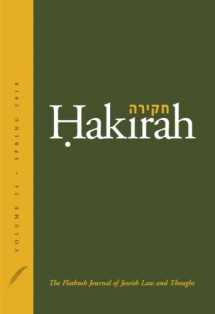
Hakirah: The Flatbush Journal of Jewish Law and Thought
Book details
Summary
Description
In "Rav Soloveitchik’s New World View," the author reviews Western philosophy, explaining that it fails to answer philosophical questions raised by modern mathematics. In a reading of The Halakhic Mind, he then demonstrates that, from his youth, the Rav felt that the key to dealing with man's encounter with the infinite lies in the dalet ammot shel halakhah. In "Historical Revisionism by the Families of Rav Kook’s Disciples" the author describes how some children of Rav Kook's students sought to distance their fathers from their teacher to ensure that their fathers' works would be accepted in Haredi circles and their reputations would remain intact. In "Rav Hildesheimer’s Response to Ultra-Orthodoxy" the author analyzes an historical document to contrast two responses to the then-budding Reform movement: that of a group which came to be called the Haredi camp, with the more moderate response of Rav Hildesheimer. In the chapter from the book on the Hazon Ish, "The Gaon of Vilna, the Hatam Sofer, and the Hazon Ish: Minhag and the Crisis of Modernity," the author argues that the Hazon Ish, considered by many to be the father of the modern Haredi movement, was not acting in response to modernity, but was motivated by a desire to find each law's intent and to follow the letter of the law. In the timely article in the Minhag section entitled "Our Salty Tears: The History and Significance of an Interpretation of Dipping in Salt Water at the Seder," the author bears out the Hazon Ish's skepticism of minhagim, showing how hallowing practices of the past sometimes distorts the reasoning behind a custom. Our Jewish History section includes the essay "Adversity and Authorship as Revealed in the Introductions of Early Hebrew Books," which recounts how, in fact, adversity was often the catalyst for the genesis of these works. In "A Tour of the Osler Library of the History of Medicine through Jewish Eyes," we get a glimpse of great Jewish doctors who, throughout history, dedicated themselves to curing the ills of all mankind. In "Teaching Musar at the FBI," a rabbi involved in kiruv explains how, at the request of the FBI, he helped those employed in the difficult job of law enforcement by giving them spiritual tools. In the other article, "Why is there no kosher meat or poultry that is certified humane?" the issue of our obligation of ve-halakhta bi-derakhav is raised. This mitzvah, which obligates us to perform acts of hesed, is also the subject of a detailed Hebrew article on the mitzvah of bikkur holim. In the Jewish Law section, "Parve Cloned Beef Burgers: Health and Halakhic Considerations" applies ancient halakhic principles to the technology of the future, while a letter to S. Y. Agnon from a rabbi, describing the rabbi's attitude towards the idea of human possession by a reincarnated soul, shows how some ancient beliefs resist the advances of science. In our Talmud Torah section, "In Search of Nimrod: Nimrod and Esau as Parallel Figures" merges modern methodology with traditional Biblical sources in an attempt to understand Hazal's attitude toward Esau. "Reinterpretation and Resistance to the Mitzvah of Tefillah" argues that the mitzvah that the Rav so often expounded upon, and that he said "was redeemed" by Rambam, was not considered of Biblical origin even by great Rishonim who followed Rambam. In "Apprehending the Divine through the Religious Act: Rabbi Yaakov Anatoli’s Introduction to Malmad Ha-Talmidim," we see how an almost forgotten medieval scholar from Provence toiled to define a religious philosophy.


We would LOVE it if you could help us and other readers by reviewing the book
Book review



